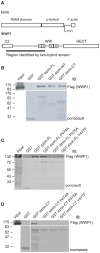Ezrin ubiquitylation by the E3 ubiquitin ligase, WWP1, and consequent regulation of hepatocyte growth factor receptor activity
- PMID: 22629406
- PMCID: PMC3358263
- DOI: 10.1371/journal.pone.0037490
Ezrin ubiquitylation by the E3 ubiquitin ligase, WWP1, and consequent regulation of hepatocyte growth factor receptor activity
Abstract
The membrane cytoskeleton linker ezrin participates in several functions downstream of the receptor Met in response to Hepatocyte Growth Factor (HGF) stimulation. Here we report a novel interaction of ezrin with a HECT E3 ubiquitin ligase, WWP1/Aip5/Tiul1, a potential oncogene that undergoes genomic amplification and overexpression in human breast and prostate cancers. We show that ezrin binds to the WW domains of WWP1 via the consensus motif PPVY(477) present in ezrin's C-terminus. This association results in the ubiquitylation of ezrin, a process that requires an intact PPVY(477) motif. Interestingly ezrin ubiquitylation does not target the protein for degradation by the proteasome. We find that ezrin ubiquitylation by WWP1 in epithelial cells leads to the upregulation of Met level in absence of HGF stimulation and increases the response of Met to HGF stimulation as measured by the ability of the cells to heal a wound. Interestingly this effect requires ubiquitylated ezrin since it can be rescued, after depletion of endogenous ezrin, by wild type ezrin but not by a mutant of ezrin that cannot be ubiquitylated. Taken together our data reveal a new role for ezrin in Met receptor stability and activity through its association with the E3 ubiquitin ligase WWP1. Given the role of Met in cell proliferation and tumorigenesis, our results may provide a mechanistic basis for understanding the role of ezrin in tumor progression.
Conflict of interest statement
Figures





References
-
- Gentile A, Trusolino L, Comoglio PM. The Met tyrosine kinase receptor in development and cancer. Cancer Metastasis Rev. 2008;27:85–94. - PubMed
Publication types
MeSH terms
Substances
LinkOut - more resources
Full Text Sources
Miscellaneous

